Live Bait Rigs
Rigging Live Bait Correctly Is An Art, Not A Science
Fishing live bait rigs is no guarantee you'll catch bass. As we all know, nothing is when it comes to actually "catching" bass. Bass are sometimes finicky beyond belief.
The oldest, smartest and biggest bass will often fall victim only to live bait. They didn't grow to be the baddest bass on the block by being dumb. They learned, or should I say, became conditioned, to avoid artificial baits. But even the biggest and smartest know real live prey when they see it. If everything looks and smells right, so to speak, they'll strike!
So it's important when you're fishing live baits to rig and present your bait correctly. What are some of the important considerations when rigging live bait?
What are some of the important considerations when rigging live bait?- Hook Placement
- Hook Size
- Line Size

How To Hook Live Bait
Hook Placement For Baitfish
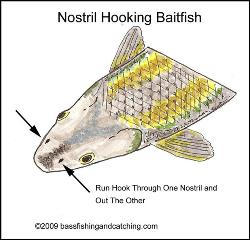
- Through Nostrils - Pass a live bait hook from one nostril under the bridge of the nose through the other. Baitfish hooked this way tend to stay on the hook better.
- Through Lips - When hooked this way they are less likely to drown when you're "dragging a minnow" behind the boat or repeatedly reeling it in and re-casting.
- Through Bottom Lip and Out One Nostril - Variation of hooking through the lips. They stay on well hooked this way.
- Behind Dorsal Fin - This is best for stationary fishing. It allows for more natural swimming action by the shiner.
- Through Tail - This inhibits natural swimming action in my humble opinion.
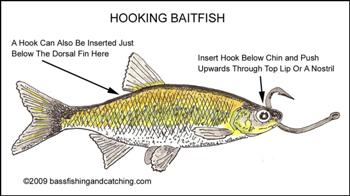
Suggested Live Bait Rigs For Baitfish
- Split-shot rig
- Slip-float rig
- Slip-sinker
Hook Placement For Crawfish
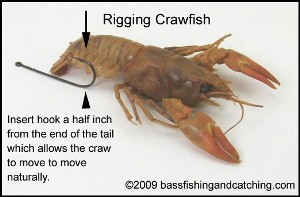
- Through the Tail - Push the hook, a straight "baitholder hook", up through the bottom of the tail about a half inch from the end. Alternatively, you can push it in through the side one or two segments from the end.
- Through the Horn - This is a good method in that it prevents the crawfish from scooting up under a rock. Unfortunately, not all crawfish have a horn tough enough to facilitate this.
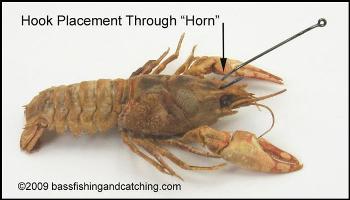
Suggested Live Bait Rigs For Crawfish
- Split-shot rig
- Slip-sinker
Hook Placement For Lizards

- In Front of Hind Leg - The tissue here is quite tough and a lizard is not able to escape a hook placed here. Additionally, it will live longer than if hooked through the lips.
- Through the Lips - A lizard is quite capable of squirming off a hook running through its lips unless small plastic stop tabs are placed on the hook to prevent this. Tabs must be positioned on the hook both above and below the lizard's lips, like bread slices of a sandwich. Where do you get these tabs? Cut them from plastic tops found on many so many food cans these days. Frankly, it's a lot of trouble. Stick them behind the leg and be done with it.
- Split-shot rig
- Slip-sinker

Most Common Live Bait Rigs
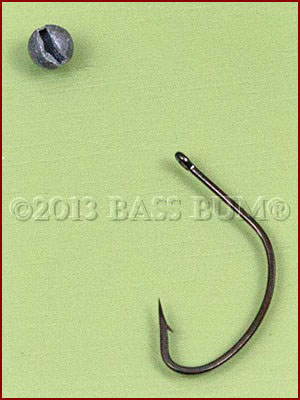
Split-Shot Rig
As live bait rigs go a split-shot rig is easy to assemble and present to bass. It's good for both still and moving water. Furthermore, should you hang up and have a break off it is quick and easy to retie.
Presentation should be slow whether fishing baitfish, crawfish or lizards. With shiners, as well as other live bait, use a "lob cast" and slowly work your bait back to the boat or shore. With baitfish like shiners you can either "freeline" or lightly lift and drop then reel three or four turns and repeat when working your bait back to the boat. With lizards and craws slowly pull the bait across the bottom to be most effective.
When fishing with shiners I always use a Gamakatsu "shiner hook" which is what is shown in the photo above right. Depending on the size baitfish being fished I'll use size 4, 2 or 1 shiner hook.
As for split-shot, I'll use a size 5 or 7, placed 12"-18" above the hook, depending on the size of the baitfish. If freelining you may not use a split-shot at all.
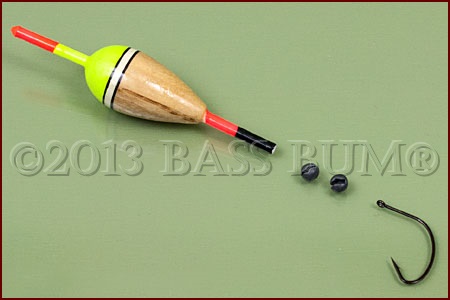
Slip-Float Rig
I know, you're thinking, "What, me fish for bass with a bobber. You gotta be kidding!". Listen, there are times when this live bait rig presentation works well.
Smallmouth often suspend in open water and about the only way to keep your bait in their faces is with a slip-float rig. When it's cold bass become sluggish and won't chase a bait. Dangling it constantly in front of them at the end of a slip-float rig can often entice a bite.
Make sure you add an appropriate amount of weight that will keep the bobber floating properly. Add too much and the float will ride too low in the water. Wave action will cause the float to dip under giving the impression you have a bite when you don't. Add too little and the float will ride too high giving too much resistance when a bite occurs possibly causing the bass to drop the bait.
When you do get a bite set the hook right away when the float goes under. If you wait the bass may feel resistance and release the bait. Also, don't set the hook till you quickly reel up slack and "feel" the fish. Because of the acute angle that exists between you and your bait setting with slack in your line will make getting a good hook set difficult.
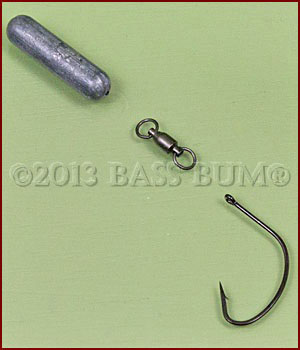
Slip-Sinker Rig
This rig allows for a bass to pick up your bait and move off without necessarily feeling resistance. You can slowly troll such a rig or cast and retrieve it. In the first instance you can keep your bail open and release the line when you feel a strike. In the second, you must quickly drop your rod tip and open your bail when detecting a strike.
In the photo I've used a "Mojo" style slip sinker. You can also
use bullet sinkers, egg sinkers or Lindy "NO-SNAGG" banana shaped
sinkers.
As you can see live bait rigging is more than just using worms for bait.
Live bait is the best bait for bass - bar none! Take time to set up
your live bait rig "correctly' and your day on the water will be very
rewarding.
Back to Fishing Live Bait From Live Bait Rigs
